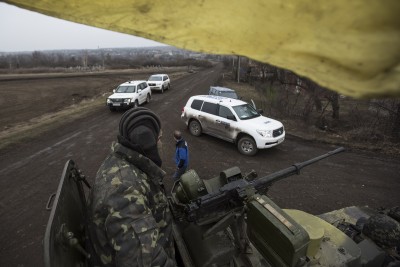Ukraine Crisis: OSCE Special Monitoring Mission Obstructed in Ukraine
The United States and European Union have expressed concern that the OSCE Special Monitoring Mission to Ukraine continues to face restrictions to its freedom of movement in Ukraine. Read about the latest impediment to the SMM's monitoring ability and what the US and EU said about it.
 European Union: "We urge the Russian Federation to respect the SMM’s mandate and ensure that all restrictions affecting the SMM’s work are lifted immediately." / Picture: © Wikimedia Commons / OSCE Special Monitoring Mission to Ukraine, CC BY 2.0 (https://creativecommons.org/licenses/by/2.0)
European Union: "We urge the Russian Federation to respect the SMM’s mandate and ensure that all restrictions affecting the SMM’s work are lifted immediately." / Picture: © Wikimedia Commons / OSCE Special Monitoring Mission to Ukraine, CC BY 2.0 (https://creativecommons.org/licenses/by/2.0)
As tensions still run high between Russia and Ukraine and Putin has massed over 100,000 troops on the border, the Organization for Security and Cooperation in Europe (OSCE) Special Monitoring Mission (SMM) to Ukraine has reported that it continues to experience restrictions to its freedom of movement in Ukraine.
The SMM reports that it is being denied the “safe and secure access throughout Ukraine” that is stipulated in its mandate.
According to its own report, “The sides continued to deny the SMM full access, as well as the ability to travel certain roads previously identified as important for effective monitoring by the Mission and for civilians’ movement, through failure to conduct comprehensive clearance of mines, unexploded explosive ordnance (UXO) and other obstacles.”
Under the Minsk Agreement, all signatories have agreed upon the need for freedom of movement for the SMM.
In addition to the mines impeding the SMM’s freedom of movement, an SMM unmanned aerial vehicle (UAV), a tool often used for monitoring, was reported to have been shot at with small arms while flying over the non-government-controlled Luhansk city in Ukraine.
The UAV also experienced GPS signal interference, which was assessed as likely to have been caused by jamming.
The European Union and the United States have both expressed concern regarding the continued denial of the SMM’s freedom of movement.
“The EU is deeply concerned regarding the restrictions to the SMM’s freedom of movement. Again last Thursday, an SMM patrol was prevented from crossing the contact line at the Stanytsia Luhanska bridge by the Russia-backed armed formations. We urge the Russian Federation to respect the SMM’s mandate and ensure that all restrictions affecting the SMM’s work are lifted immediately,” said the EU in an official statement.
In an interview, the Permanent Representative of the United States to the OSCE, Michael Carpenter, said, “We have heavy weapons in the proscribed zones, and we have blockages on the ability of the OSCE’s SMM mission to monitor the full entirety of the region of Ukraine, not to mention the fact that one of the key provisions of the Minsk agreements which called for monitoring of the international border between Russia and Ukraine, that mission on the border was vetoed by Russia last year.”
About the SMM to Ukraine
The OSCE Special Monitoring Mission to Ukraine (SMM) was deployed on 21 March 2014, following a request to the OSCE by Ukraine’s government and a consensus decision by all 57 OSCE participating States.
The SMM is an unarmed, civilian mission, present on the ground 24/7 in all regions of Ukraine.
Its main tasks are to observe and report in an impartial and objective way on the situation in Ukraine and to facilitate dialogue among all parties to the crisis.
The SMM provides daily reports, spot reports on specific incidents, and thematic reports about general trends in their area of operation.



